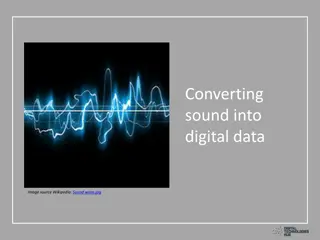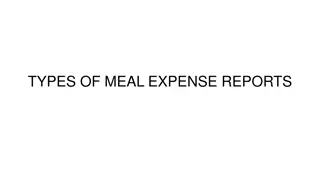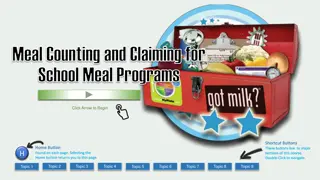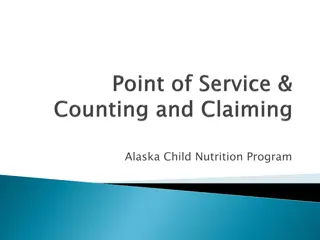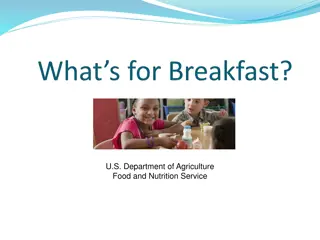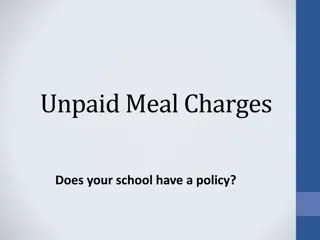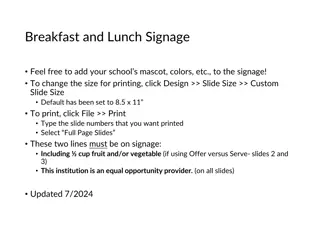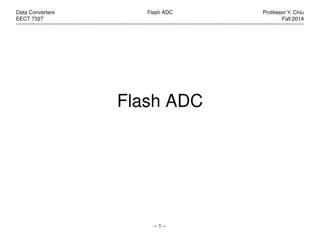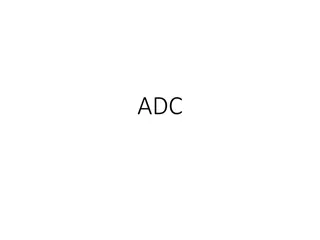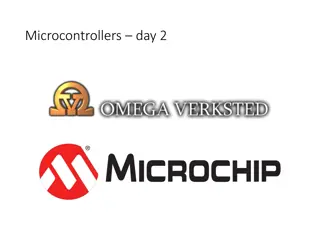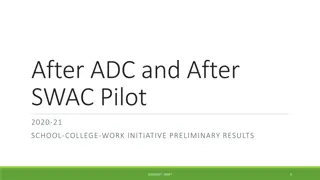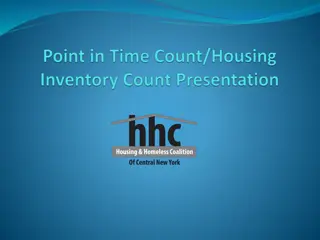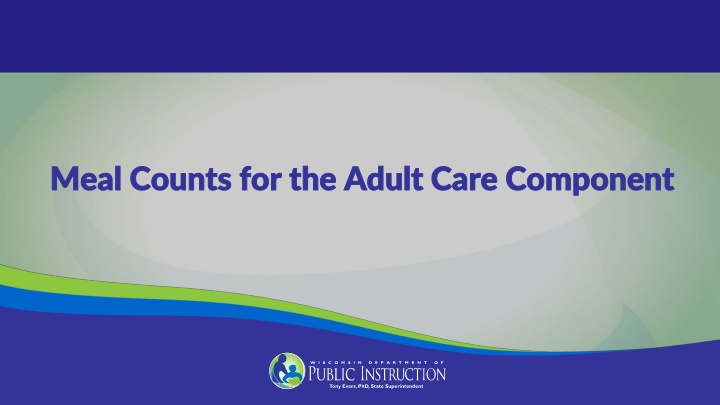
How to Record Meal Counts for Adult Care Component Clients
Learn about the importance of recording meal counts for the Adult Care Component, including who records them, where they are recorded, and using the Record-by-Name Meal Count Form for accurate tracking. Ensure compliance and reimbursement by following these guidelines.
Download Presentation

Please find below an Image/Link to download the presentation.
The content on the website is provided AS IS for your information and personal use only. It may not be sold, licensed, or shared on other websites without obtaining consent from the author. If you encounter any issues during the download, it is possible that the publisher has removed the file from their server.
You are allowed to download the files provided on this website for personal or commercial use, subject to the condition that they are used lawfully. All files are the property of their respective owners.
The content on the website is provided AS IS for your information and personal use only. It may not be sold, licensed, or shared on other websites without obtaining consent from the author.
E N D
Presentation Transcript
Meal Counts for the Adult Care Component Meal Counts for the Adult Care Component
Meal and Snack Count Records Client s Residential Status Meal and Snack Count Records Fully Record at time of service Compliant Meal
What are Meal Counts? Reimbursed for the number of compliant meals and snacks served each day to clients who are eligible to participate in the CACFP Time of Service Meal Count: Record meal counts at the time of each meal or snack service, or immediately after
Who Records Meal Counts? Designate specific staff to record meal counts at the time of service at each meal They must have a good understanding of who the eligible clients are and what meals are compliant with the meal pattern
Where are Meal Counts Recorded? Most common: Record only eligible clients by their names Record a total count during the meal Use the Daily Participation Meal Count Record Form Use the Record-by-Name Meal Count Form Both forms are found under GM 9A at http://dpi.wi.gov/community-nutrition/cacfp/adult-care/memos
Using the Record-by-Name Meal Count Form List all eligible client s full names in the first column During the meal service,record a check next to each name who was served a compliant meal
Using the Record-by-Name Meal Count Form 7+11+12+11+8= 49
Using the Record-by-Name Meal Count Form Weekly Subtotals for: Week 1 + Week 2 + Week 3 + Week 4 =Monthly Meal Count Total 196 224 420 Total of ALL meals served for the month
Using the Daily Participation Meal Count Record Only use the total count method for recording meal counts if all clients are eligible for the CACFP During meal service, count the number of clients served a fully compliant meal/snack Record this total count under the correct meal/snack column, for the correct day
Compiling Time of Service Meal Counts on the Daily Participation & Meal Count Record At the end of the month, add the daily meal counts together, within each column on the meal count form, to get a total. Lunch Count: 27+25+26+27+26+20
Compiling Time of Service Meal Counts on the Daily Participation & Meal Count Record Month: November Date Breakfast AM Snack Lunch PM Snack 27 18 17 28 29 30 31 Total 411 443 Monthly Claim for Reimbursement
Accurate Meal Count Totals When compiling the meal counts for the monthly claim: Double check the meal count tallies for each meal to assure they are accurate. Calculate the total monthly meal counts at least twice. Have another person double check your tallies and calculations This is a best practice!
Meal Counts Cannot Be Based on computerized or manual attendance records Does not meet the definition of a Time of Service Meal Count
Meal Counts Cannot Be Recorded based on the number of clients expected to eat a meal or snack Example: The Cook is provided with the number of clients in attendance in the morning and is going to prepare the meal based on this number. This number cannot be transferred to the meal count form for each meal or snack that day. Clients do unexpectedly leave and/or arrive throughout the day, get sick, or decide they do not want to sit and eat a meal.
Meals Served to Others The number of meals served to program staff, non- eligible clients, and non-program staff (as well as others) cannot be recorded in the meal counts that will be submitted on the reimbursement claim But: They must be documented in food program records and noted in the projected meal counts of the production records Food service expense for some of these meals can be covered by CACFP funds, others cannot.
Non-eligible Clients Do not meet client eligibility criteria: live in CBRFs, Adult Family Homes, or Nursing Homes Cannot be counted within meal counts submitted for CACFP reimbursement But: CACFP funds can be used to cover the food costs incurred for serving them meals
Program Staff Perform necessary labor (paid or donated) for the food service program Program staff responsible for: menu planning preparing and serving meals cleanup after meals supervision of clients during meals on-site recordkeeping Cannot be counted within meal counts submitted for CACFP reimbursement But, CACFP funds can be used to cover the food costs incurred for serving program staff meals
Non-Program Meals Non-program meals are those served to staff who do not perform any necessary labor in support of the food program and Visiting relatives, visiting clergy, licensing inspectors, DPI, and/or USDA personnel etc. CACFP funds cannot be used to cover for food service costs incurred for non-program meals served. Your agency must use other funds to cover the cost of non-program meals
Other Meal Program Funds Meals reimbursed or food service expenses covered by funding from the Federal Elderly Nutrition Program (Title III funds of the Social Security Act) These meals cannot be claimed for CACFP reimbursement and CACFP funds cannot be used to cover for food service costs In WI, the Department of Health and Family Services administers the Federal Elderly Nutrition Program
Non-Discrimination Statement (NDS) In accordance with Federal civil rights law and U.S. Department of Agriculture (USDA) civil rights regulations and policies, the USDA, its Agencies, offices, and employees, and institutions participating in or administering USDA programs are prohibited from discriminating based on race, color, national origin, sex, religious creed, disability, age, political beliefs, or reprisal or retaliation for prior civil rights activity in any program or activity conducted or funded by USDA. Persons with disabilities who require alternative means of communication for program information (e.g. Braille, large print, audiotape, American Sign Language, etc.), should contact the Agency (State or local) where they applied for benefits. Individuals who are deaf, hard of hearing or have speech disabilities may contact USDA through the Federal Relay Service at (800) 877-8339. Additionally, program information may be made available in languages other than English. To file a program complaint of discrimination, complete the USDA Program Discrimination Complaint Form, (AD-3027) found online at: http://www.ascr.usda.gov/complaint_filing_cust.html, and at any USDA office, or write a letter addressed to USDA and provide in the letter all of the information requested in the form. To request a copy of the complaint form, call (866) 632-9992. Submit your completed form or letter to USDA by: (1) mail: U.S. Department of Agriculture Office of the Assistant Secretary for Civil Rights 1400 Independence Avenue, SW Washington, D.C. 20250-9410; (2) fax: (202) 690-7442; or (3) email: program.intake@usda.gov. This institution is an equal opportunity provider.


